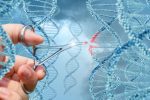Gene Therapy Strategy Restores Motor Learning in Early Mouse Study

A novel dual gene therapy rescued the function of the UBE3A gene in a mouse model of Angelman syndrome, the gene that is faulty in people with the condition, and restored motor-skill learning and essential behaviors, a study has demonstrated.
“This was a proof-of-concept study, but if these early results were translated to the clinic, they would represent big improvements in the quality of life for individuals with Angelman syndrome,” Matt Judson, PhD, from the University of North Carolina (UNC) School of Medicine and the study’s lead author, said in a press release.
The study, “Dual-isoform hUBE3A gene transfer improves behavioral and seizure outcomes in Angelman syndrome model mice,” was published in the journal JCI Insight.
Angelman syndrome is caused by a mutated or deleted copy of the maternal UBE3A gene, which carries instructions for the production of ubiquitin protein ligase E3A (UBE3A), an enzyme that targets other proteins for degradation within cells. For unknown reasons, only the maternal copy of UBE3A, but not the paternal copy, is normally active in mature nerve cells (neurons) in specific brain regions.
Gene therapy is a potential treatment strategy for Angelman patients, which aims to restore gene activity by delivering a functioning copy of UBE3A to neurons.
However, neurons typically express (produce) two different forms of the UBE3A enzyme that differ in length — a short form and a long form — in a three to one ratio. Thus, a simple replacement of the UBE3A gene may not be sufficient to achieve desired clinical outcomes.
Researchers based at the UNC have now designed a dual gene therapy that expresses both the short and long forms of the UBE3A protein at a near-normal ratio in neurons.
In the study, funded by the Angelman Syndrome Foundation, the team tested this gene therapy in mice that lack the maternal copy of the UBE3A gene. Like in human patients, these mice fail to express UBE3A protein in neurons and develop Angelman symptoms in the first months of life, including motor deficits, seizures, and other neurological impairments.
The gene therapy was packaged into a harmless, modified adeno-associated virus and delivered directly into the brains of newborn Angelman mice via injection into the hollow spaces called ventricles.
Initial experiments confirmed the expression of both short and long forms of UBE3A in treated Angelman mice brain tissue at a ratio of 2.7-to-1. In comparison, normal, healthy mice had a short- to long-form ratio of 3.5-to-1, and in human brain samples, this ratio was previously determined to be about 3-to-1.
Additional tests showed that the gene therapy reinstated widespread distribution of UBE3A in the brains of Angelman mice with healthy enzymatic activity.
To determine the efficacy of the therapy, the scientists assessed the behavioral performance of adult Angelman and normal littermate mice treated as newborns.
Before testing, birth weight was monitored during development and no difference was found between healthy and treated Angelman mice in the first month, “thus indicating generally good tolerance of the treatment,” the researchers noted.
In this model, excessive adult weight gain has been well-documented and corresponds to obesity in adults with Angelman syndrome. By two months of age, untreated Angelman mice showed increased body weight relative to healthy mice. Although the results were inconclusive for treated male mice, excessive adult weight gain was seen in treated female Angelman mice, which indicated a lack of efficacy of this gene therapy for weight gain.
Motor impairment is a feature of Angelman, which was demonstrated by the poor performance of Angelman mice on behavioral tasks, such as the open field test (a test to evaluate general locomotor activity levels and willingness to explore) and accelerating rotarod tests (to evaluate the animals’ motor coordination).
A comparison of treated and untreated Angelman mice in open field tests showed no difference. In contrast, treated mice demonstrated increased learning abilities in rotarod performance, which translated into significant motor improvements, similar to healthy controls.
Angelman mice also have impairments in species-specific behavioral routines such as digging and nest-building. Treatment with the gene therapy was found to rescue deficits in digging behavior in Angelman mice in a marble burying test.
In addition, healthy mice built robust nests incorporating most of the available nesting material over the five-day testing period. Although treated Angelman mice fell short of matching the nest-building ability of normal mice, they outperformed untreated Angelman mice.
“Overall, these findings support that neonatal gene transfer … confers to [Angelman] mice a markedly increased capacity to learn motor tasks and express innate, species-typical behaviors,” the scientists wrote.
Because about 90% of Angelman patients also suffer from epileptic seizures, the researchers chemically induced seizures in the mice over eight days. Then, after 28 days without seizure induction, the mice were re-exposed. Both normal and treated Angelman mice rebounded toward day one seizure levels, whereas untreated Angelman mice did not.
According to the team, the “rescue of enhanced rechallenge sensitivity in [treated Angelman] mice suggests that [gene therapy] treatment may have the capacity to mitigate” related pro-epileptic features in Angelman mice.
Moreover, an examination of the area of the brain involved in seizure development, known as the hippocampus, in normal mice and treated Angelman mice revealed similarities following seizure induction and rechallenge.
“Collectively, these data demonstrate the potential for neonatal gene transfer … to improve seizure outcomes associated with [Angelman syndrome],” the researchers wrote.
Finally, as UBE3A overexpression is a particular concern for gene transfer approaches to treat Angelman, the team conducted post-mortem tissue analysis of the mice. UBE3A overexpression frequently occurred in the hippocampus but was uncommon in other major brain structures and was not associated with behavioral performance.
Overall, “our results demonstrate the feasibility, tolerability, and therapeutic potential for dual-isoform [human] UBE3A gene transfer in the treatment of [Angelman syndrome],” the team concluded.
The researchers plan to further optimize the dose and delivery method of the gene therapy and ultimately, pending promising safety results, launch human clinical trials. The team believes such gene therapy could be of benefit to patients of any age, albeit possibly at varying degrees.
“The range from birth to four years is probably ideal, but we think that whenever we can reinstate this gene’s function in the brain, we’re likely to see some improvements,” Ben Philpot, PhD, the study’s senior author, concluded.








